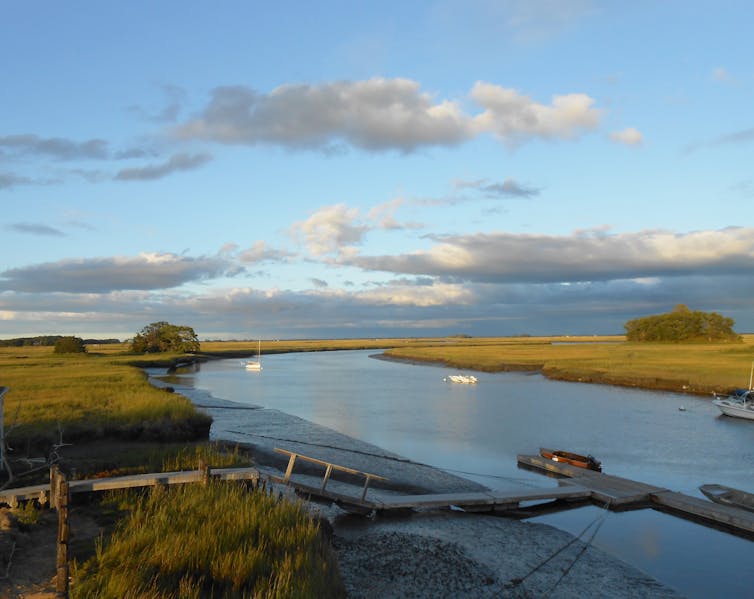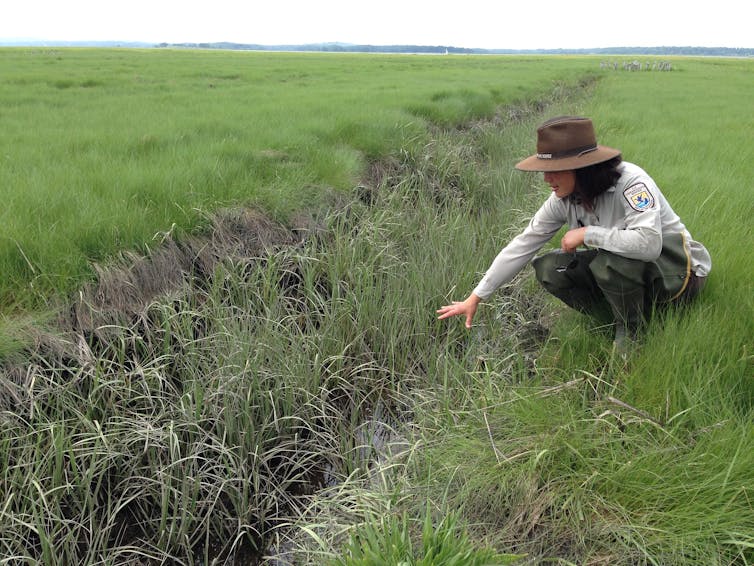How a thumb-sized climate migrant with a giant crab claw is disrupting the Northeast's Great Marsh e
South of Cape Cod, fiddler crabs and marsh grass have long had a mutually beneficial relationship. It’s a different story in the North, where the harms can ricochet through ecosystems.

Nine years ago, I stood on the muddy banks of the Great Marsh, a salt marsh an hour north of Boston, and pulled a thumb-sized crab with an absurdly large claw out of a burrow. I was looking at a fiddler crab – a species that wasn’t supposed to be north of Cape Cod, let alone north of Boston.
As it turned out, the marsh I was standing in would never be the same. I was witnessing climate change in action.
The Great Marsh is on the Gulf of Maine, the piece of the Atlantic that extends approximately from Cape Cod, Massachusetts, to Nova Scotia, Canada. The marshes along the gulf are critical breeding sites for many bird species. But the water there is warming faster than almost anywhere else on the planet. And with warming water comes warm-water species.

Maryland blue crab and black sea bass, both southern species, are now being caught in Maine lobster traps. And fiddler crabs, whose charismatic males have oversized claws to attract mates and defend against rivals, are marching up the Eastern Seaboard.
This rapid migration is due, in part, to their young. While adult fiddler crabs scuttle on the mud, their young swim in the water and are carried by the currents. Warming waters allow them to complete their life cycle, and currents carry the next generation farther north.
As a marine ecologist who has worked in the Great Marsh for decades and studies climate migrants – species that have shifted or expanded their ranges due to climate change – I want to know how these migrations affect the ecosystems they move into. I was surprised to find fiddler crabs in the Great Marsh, but I was more surprised by how they affected the marsh.

Fiddler friend turns foe
Salt marshes are grasslands flooded daily by the sea. Imagine a Midwest prairie as oceanfront property.
South of Cape Cod, decades of research has shown that when fiddler crabs are present, grass is more productive. Fiddler-crab poop and burrows release nutrients and fuel plant growth. They are the earthworms of the salt marsh – they help plants grow.
But in the Great Marsh, it isn’t working that way.
Digging by fiddler crabs reduced the biomass of shoots and leaves in the Great Marsh by 40% and roots by 30% over the course of the summers of 2020 and 2021. That’s the opposite of what we would predict for summer growth.
I was surprised because the crabs were coexisting with the same plant species, Spartina alterniflora, in the Great Marsh as they were south of Cape Cod.
Why the different impacts? One reason is that while they may be the same species, these plants haven’t evolved with fiddler crabs as their southern kin have. Fiddler crabs don’t eat the grass, but when they dig, they damage Spartina’s roots. Plants in southern areas have adapted to this damage and now benefit from it, but plants in the North have yet to adapt.
A chain reaction through the ecosystem
The harm from this disruption can go well beyond the grasses to affect the rest of the Great Marsh food web.
Insects, spiders, snails and small crustaceans all rely on the grasses for food. These animals, in turn, are food for fish, shrimp and crabs. Less plant biomass could lead to fewer fish and shrimp. The many birds that breed in the marsh and stop there during migration rely on that food web.
Will this harmful relationship with crabs last forever for the plants? Probably not. Spartina has been able to adapt to new conditions within decades. Plants in the Great Marsh, and the rest of the Gulf of Maine, will likely adapt to the fiddler’s presence over time, too.
In the meantime, however, fiddler crabs may magnify the impacts of climate change in the area.

Accelerated sea level rise driven by warming temperatures already threatens to drown the Great Marsh. Salt marshes have kept pace with sea-level rise for millennia the same way you might deal with rising water threatening your house – by building up. Plants build marshes by trapping sediment brought in with each tide. Less grass could mean less marsh, and the marsh could drown.
Fiddler crabs also reduce the Great Marsh’s ability to store carbon. Salt marshes are giant compost piles that take centuries to rot, if ever. Every gardener knows that temperature and oxygen get a compost pile cooking. This is why you turn your compost.
Each year, dead plant roots are buried in soils with no oxygen. As a result, decomposition is greatly slowed, allowing the “compost” and carbon to build up and be stored. Because of this, salt marshes are critical as places that store carbon, keeping it out of the atmosphere where it would contribute to climate change. However, burrows from fiddler crabs stimulate decomposition. The dead plants begin to rot, and carbon, once buried, is released.
Climate migrants are found worldwide
Fiddler crabs are just one of thousands of climate migrants we’ve seen worldwide. While ecosystems will adapt as climate migrants arrive, they will likely never be the same.
In Australia, when an herbivorous sea urchin expanded its range south, plant and animal diversity plummeted after kelp forests were stripped bare. In California, a predatory nudibranch (aka a sea slug) reduced the local population of other nudibranchs when it migrated north. In Antarctica, krill are shifting south. Krill are the primary diet for whales, penguins and seals, so this shift could disrupt the Antarctic food web.

But it’s not always bad news when climate migrants show up.
When mangroves replace marshes in the southern United States, they store more carbon. Climate migrants can also benefit fisheries.
My lab studies the blue crab, famous in the Chesapeake Bay, which generated over US$200 million in dockside landings in 2022. Now that blue crabs are being found in lobster pots in Maine, a fishery could be developed in northern Massachusetts, New Hampshire and Maine. However, it’s unknown how blue crabs and lobsters will get along.
In Virginia, warming waters have brought an abundance of white shrimp along with a new fishery. To the delight of anglers, the snook – a fun sportfish – has expanded into the Big Bend of Florida in the Gulf of Mexico.
More migration is still to come
The year 2023 set a record for heat waves in the world’s oceans, and with greenhouse gases emissions still rising, warming will continue.
While climate migrants are not considered invasive species, they can change ecosystems, as we’re already seeing in the Great Marsh. It’s important to understand how that happens, and whether ecosystems can adapt as species continue to change their ZIP codes.
David S. Johnson receives funding from the National Science Foundation..
Read These Next
West Antarctica’s history of rapid melting foretells sudden shifts in continent’s ‘catastrophic’ geo
A picture of what West Antarctica looked like when its ice sheet melted in the past can offer insight…
From truce in the trenches to cocktails at the consulate: How Christmas diplomacy seeks to exploit s
World leaders like to talk up peace at Christmastime. But alongside the tales of seasonal breaks in…
How to reduce gift-giving stress with your kids – a child psychologist’s tips for making magic and a
Depending on family circumstances and a child’s personality type, gift giving runs the gamut of fun…






